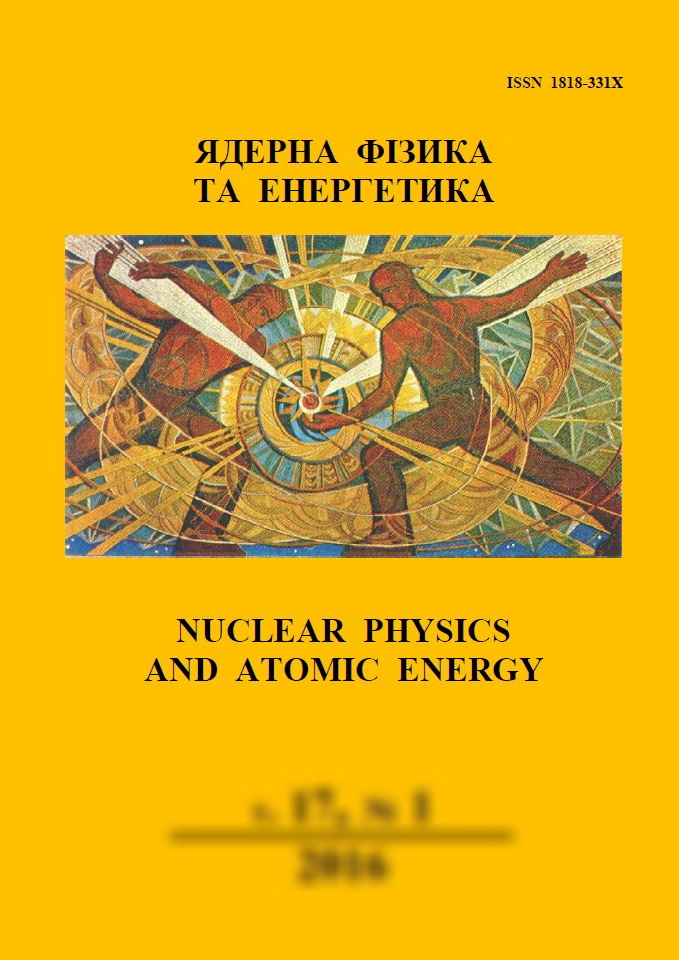 |
Ядерна фізика та енергетика
Nuclear Physics and Atomic Energy
ISSN:
1818-331X (Print), 2074-0565 (Online)
Publisher:
Institute for Nuclear Research of the National Academy of Sciences of Ukraine
Languages:
Ukrainian, English, Russian
Periodicity:
4 times per year
Open access peer reviewed journal
|
Nucl. Phys. At. Energy 2017, volume 18, issue 2, pages 201-205.
Section: Engineering and Methods of Experiment.
Received: 07.12.2016; Accepted: 12.10.2017; Published online: 22.11.2017.
 Full text (en)
Full text (en)
https://doi.org/10.15407/jnpae2017.02.201
Study of bremsstrahlung photons in bulk target using MCNP code
S. Sangaroon*, W. Tuisakda
Department of Physics, Faculty of Science, Mahasarakham University, Mahasarakham, Thailand
*Corresponding author. E-mail address:
siriyaporn.s@msu.ac.th
Abstract:
The aim of this research was to study the feasibility of bremsstrahlung photon production in target bombarded by 1 GeV electrons. The calculations were performed by the Monte Carlo code MCNP. Six target materials with densities between 2 and 20 g/cm3 were studied. The bremsstrahlung photon flux is high for the target density above 8 g/cm3. Copper is the best target for 1 GeV electron beam due to high bremsstrahlung photon production, low scattering and low transmission electron flux. The copper target was altered to have different thicknesses between 0.01 and 2.5 cm. The results showed that the bremsstrahlung photon flux significantly increased when the target thickness increased from 0.01 to 1.5 cm. The angular distribution of the bremsstrahlung photons with angles between 0 and 120 degrees was determined for copper target. The maximum angle of the photon scattering was about 20 degree.
Keywords:
bremsstrahlung, electron beam, MCNP simulation.
References:
1. J.J. DeMarco et al. A verification of the Monte Carlo code MCNP for thick target bremsstrahlung calculations. Medical Physics 22 (1995) 11.
http://doi.org/10.1118/1.597528
2. K. Kosako et al. Angular distribution of bremsstrahlung from copper and tungsten targets bombarded by 18, 28, and 38 MeV electrons. Journal of Nuclear Science and Technology 47 (2010) 286.
http://dx.doi.org/10.1080/18811248.2010.9711956
3. S. Sujitjorn. Thai synchrotron facility: Its past and present. Suranaree Journal of Science and Technology 22(3) (2015) 227.
http://ird.sut.ac.th/e-journal/Journal/pdf/1506899.pdf
4. D.P. Gierga. Electron photon calculations using MCNP: Master Thesis (Massachusetts Institute of Technology, USA, 1996).
Thesis
5. B.J. Patil et al. FLUKA simulation of 15 MeV linear accelerator based thermal neutron source for radiography Indian Journal of Pure & Applied Physics 50 (2012) 814.
http://nopr.niscair.res.in/handle/123456789/14911
6. Q. Gao et al. Design and optimization of the target in electron linear accelerator. In: 4-th Intern. Particle Accelerator Conf. (Shanghai, China, 2013).
Article
7. A. Tsechanski et al. A thin target approach for portal imaging in medical accelerators. Physics in Medicine and Biology 43 (1998) 2221.
https://doi.org/10.1088/0031-9155/43/8/016
8. J.E. Sweezy. Los Alamos National Laboratory: MCNP - A general Monte Carlo N-Particle transport code, version 5, LA-CP-03-0245 (2008).
Volume II: User’s Guide
